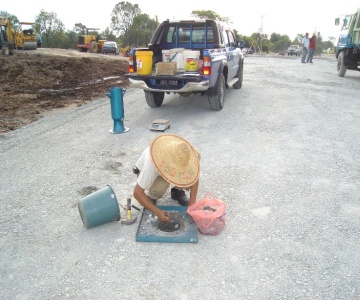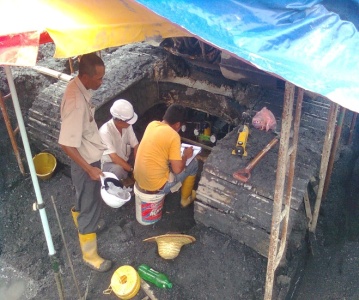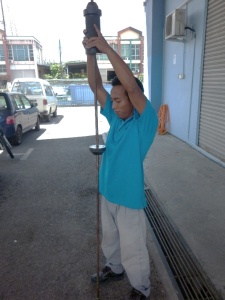Soil, Foundation, Geotechnical and Geological Specialist.......
|
|
|
|
Field Testing
a) Field Density Test Using Sand Replacement Method (BS 1377 : Part 9 : 1990)
b) In-situ CBR Test (BS 1377 : Part 9 : 1990) c) Plate Bearing Test (ASTM D 1194 – 72) d) Mackintosh Probe Test e) Concrete Coring Test (BS 1881 : Part 120 : 1983) f) Core Cutter Method (BS 1377 : Part 9 : 1990) g) Dynamic Cone Penetrometer Test (AS 1289. F3.2 – 1984)
(a) FIELD DENSITY TEST USING SAND REPLACEMENT METHOD
Field Density testing using Sand Replacement method is the industry standard in field density soil testing. This test method is suitable for fine and medium grained soils by using small pouring cylinder (115mm diameter) and for fine, medium and coarse grained soils by using large pouring cylinder (200mm diameter).
(b) IN-SITU CBR TEST
The In-Situ CBR Test method of flexible pavement design
is essentially an empirical method in which design curves are used to estimate a pavement thickness appropriate to the CBR of the soil.
There is no unique CBR of a soil, and in any CBR test the value obtained depends very much on the manner in which the test is conducted.
The design curves are usually based on one-carefully specified method of measuring the CBR, and usually a laboratory method.
The parameter required for the design of flexible pavements is the CBR attained by the soil at formation level after all
necessary compaction has been carried out, the pavement has been laid and sufficient time has elapsed for equilibrium moisture content to become established. Before embarking on insitu CBR tests,
it is therefore necessary to consider carefully how relevant they will be to the proposed design method and whether the condition of equilibrium moisture content is likely to pertain. The test involves driving a
cylindrical plunger of a defined area into the soil at a uniform rate. This requires the use of a reaction load, (usually an Excavator or Roller Compactor), to provide the force.
(c) PLATE BEARING TEST
In design of shallow foundation or traffic surface, design engineers need to know the bearing capacity of
soil underneath. It is carried out in the field to serve this purpose. Results from the test can be used as design parameter or used to confirm the design assumption. Plate bearing tests involve jacking a plate of known dimensions against a reaction load, usually the underside of a tracked excavator and recording the ground deformation. Different tests are used to assess the bearing capacity of the soil and the prediction of settlement characteristics. The modulus of sub-grade reaction can be measured and correlated with CBR which is useful for assessing gravelly material when a normal CBR test is inappropriate.
(d) MACKINTOSH PROBE TEST / JKR PROBE
The mackintosh probe (MP) development was based on the principles stated by Hvorslev (1948) for drive rods for sounding
and sampling and recommended methods for static and dynamic sounding by European Group Subcommitte (1968). This is a dynamic
penetrometer test need to check the consistency of subsoil. The MP has 30o cone penetrometer while JKR probe has 60o cone penetrometer. IT is a light dynamic test and the cone is driven directly into the soil by driving a hammer 4.5 kg. Weight dropping through a free height 280 mm. The probe is unable to penetrate into medium strength soil and gravelly ground.
(e) CONCRETE CORING TEST
(f) CORE CUTTER METHOD
This test is used for determination of in-situ dry density of natural or compacted fine grained soil, free from aggregate.
A cylindrical cutter is used to extract a sample of the soil with the help of a dolley and rammer. From the weight, density
and the moisture, and dry density of the soil is readily calculated.
(g) DYNAMIC CONE PENETROMETER (DCP)/FALLING WEIGHT PENETROMETER
DCP Test is used for rapid in-situ measurement of the structured properties of existing road pavement constructed with unbound materials. Measurement can be made down to a depth of 800 mm or to a maximum depth of 1500 mm by adding an extension rod. The penetration of the cone is measured after each blow and is recorded to provide a continuous measure of shearing resistance up to 5 feet below the ground surface.
The test results can be corrected to California bearing ratios in-situ density resilient modulus and bearing capacity.
|







